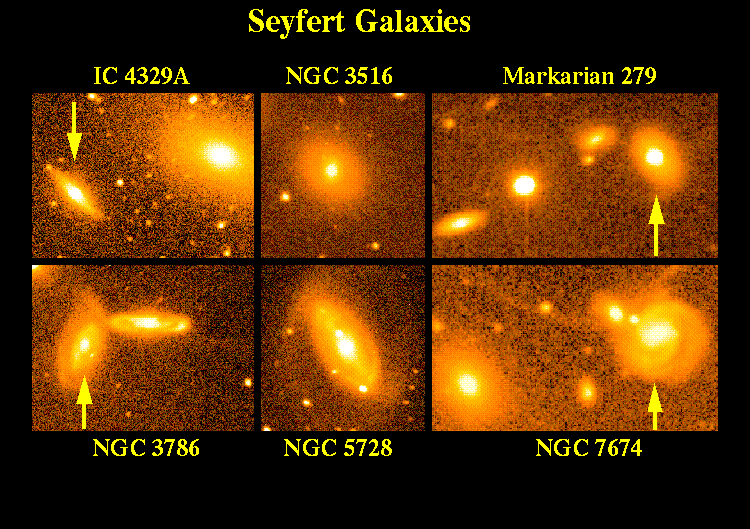
This montage uses ground-based wide-field images to exhibit the variety of types and environments in which Seyfert are found. Of these, IC 4329A, NGC 3516, and Markarian 279 are type 1 Seyferts, NGC 3786 is an intermediate "type 1.5" nucleus", and NGC 5728 and NGC 7674 are type 2 objects. This set includes fairly isolated galaxies (NGC 3516 and 5728) as well as several undergoing gravitational interactions with close neighbors, which has been widely suspected of contributing to the Seyfert phenomenon. IC 4329A is found in a rich cluster, with a giant elliptical galaxy seen in the field. This galaxy is noteworthy for being among the handful of known Seyfert galaxies seen edge-on, where the brilliant nuclear radiation manages to be attention-getting even after passing through the galaxy's entire dusty disk. NGC 3786 is interacting with its neighbor NGC 3788, as seen both from the plume of stars ejected from NGC 3788 and the asymmetric disk of NGC 3786 itself. Markarian 279 is part of a small group of galaxies, as is NGC 7674; this galaxy is in the midst of a complex interaction as shown by its two long, thin tidal tails stretching across the image. All these galaxies show the characteristic intense, pointlike nucleus originally remarked for this class by Carl Seyfert. The galaxies' Hubble types are also representative for Seyfert galaxies as a group, dominated by early-type spirals (Sa and Sb, with both barred and nonbarred representatives) and S0 systems.
These are V-band images taken using a Texas Instruments CCD at the 1.1-m Hall telescope of Lowell Observatory, described in detail by Keel in the Astronomical Journal (vol. 111, p. 696, 1996). All have north at the top and east to the left except NGC 3786, which has north to the right to fit in the montage. The areas shown range from 2.0x3.5 arcminutes for Mkn 279 and NGC 7674, through 3.5 arcminutes square for NGC 3516 and 5728, to 3.5x4.7 for IC 4329A and NGC 3786. A logarithmic intensity mapping was used to enhance the visibility of both bright and faint structure.